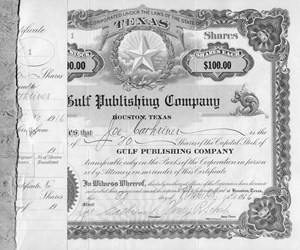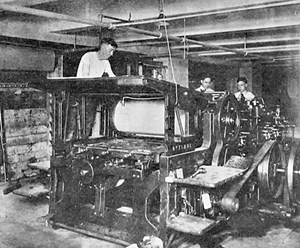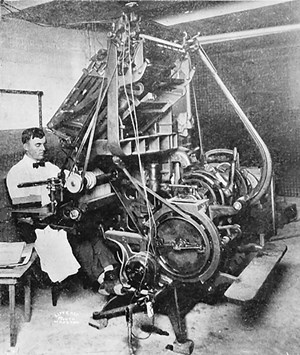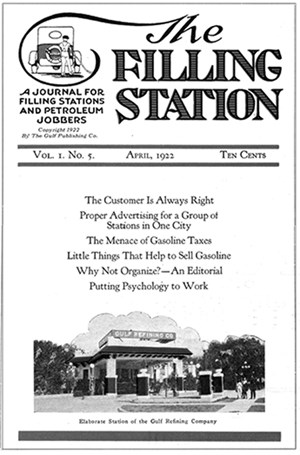Gulf Publishing Company: Growing during the days of gushers

The era of 1916–38 was one of great destruction and high creativity. When Gulf Publishing Company (GPC) was established in 1916, the war to end all wars was wreaking havoc in Europe. Then came the Great Depression, caused by the Wall Street crash of 1929. Out of this physical and financial destruction, emerged a series of creative impulses. Big Band and Jazz music ruled the day. Women were liberated from corsets and full-length dresses by Flappers in high society, and there was the extravagance of the Roaring 20s. Throughout this period, the oil industry grew from the days of wildcatting and great gushers to an industry governed by equipment standards, proration and conservation.
Top-tier support. It was in 1916 that Ray Lofton Dudley, oil reporter for the Houston Post daily newspaper, envisioned the need for a publication that catered specifically to the oil industry. In forming Gulf Publishing Company, Mr. Dudley received support from the leading oil businessmen of the day: Ross Sterling, president, Humble Oil & Refining Co., and Governor of Texas (1931–33); Howard Hughes, Sr., founder of Hughes Tool Co.; Will Farish, Vice President, Humble; Jas. Abercrombie, founder, Cameron Iron Works; and Charles H. Lane, independent oil producer. The first capital stock was set at $7,000.

On the executive side, GPC was led by Joe Cathriner, President; F. B. Mitchell, V.P. and Business Manager; and R. L. Dudley, Secretary-Treasurer and Editor. Mr. Cathriner was the manager of the Houston Stock Exchange. While continuing to work at the Houston Post, Mr. Dudley also edited the Gulf Coast Oil News from the stock exchange office in downtown Houston’s Foster building. Three months later, the magazine office was shifted to the more spacious 6th floor of the Goggan building at Main and Capitol streets.
Early growth. By 1919, GPC’s capital stock amount was increased to $35,000. The company’s net worth had risen to $37,103. Among the company’s assets included War Savings Stamps worth $148.05. Federal income tax amounted to $129.27. A promissory note was issued to Mr. Dudley for $450, with a due date of Aug. 10, 1920. In the accounts payable for 1919, the bill from Western Union Telegraph Co. of $43.33 was more than the telephone bill from Southwestern Telegraph & Telephone Co. of $20.20.

The early growth was not easy. “During the first years, meeting the payrolls was a major problem,” reported a GPC memo written in 1936. “In many instances, checks were mailed to employees in branch offices with the hope that by the time they were returned to the bank, we would have funds available to cover them.”
Stock consolidation. An editorial published in the Oct. 2, 1931 issue of The Oil Weekly revealed that Publisher Ray Dudley was GPC’s major stockholder. The editorial further explained, “We folks, who work on The Oil Weekly, own more than 76% of the voting stock and 100% of the non-voting stock in the corporation, and if any of us owe anybody for our stock, it is because we have gone to the bank and borrowed money to buy every share that was offered for sale by anybody!”
Over the passage of 100 years, there is no information regarding the early departure of Cathriner and Mitchell in 1918. While Mr. Mitchell received a fond farewell message in the Gulf Coast Oil News, when he left to join the U.S. Army, Mr. Cathriner’s departure was abrupt and without publicity.
One could speculate that as manager of the Houston Stock Exchange, Mr. Cathriner may have had an interest in cultivating financial interest in oil company stock traded at the exchange. On the other hand, Mr. Dudley wanted to publish a magazine exclusively for oil producers. Mr. Dudley’s disdain for oil-stock speculation was confirmed in 1922, when he wrote, “The Oil Weekly wants only such subscribers as are engaged in the oil producing or pipe line business. It has no desire for investor circulation, and it reserves the right and will exercise the right to reject subscriptions from persons whose only interest in the oil industry is through the purchase of oil stock.”

Vertical integration. Necessity became the driver for Gulf Publishing Company’s growth into printing and book publishing. “As circulation grew, it outgrew the publication houses of Houston,” explained GPC President Dudley in the Oct. 18, 1919 issue of The Oil Weekly, “Finally recognizing that the editorial and advertising ends of the journal were not getting the support due them in mechanical make-up and in speed of production, it was decided to install a complete publishing plant.”
The printing purchases included two Babcock Optimus presses, latest type of composing cabinets capable of storing 124 pages to the cabinet, a Seybold cutting machines, two stitchers and a Brown folder, with automatic feeder. The equipment was installed initially in the Hermann building. In 1922, GPC built its own office and printing plant at 1716 Dallas Avenue.

The availability of the printing plant led GPC to enter the technical book publishing industry. Some of the well-known reference books on petroleum engineering and geophysical exploration were published from GPC’s own printing plant.
Specialized publications. GPC was the first to foster the idea of presenting specialized information about the petroleum industry’s distinctly different operations. In 1922, Gulf Publishing put this philosophy into practice by dividing up The Oil Weekly circulation into two other publications—The Petroleum Refiner and Natural Gasoline Manufacturer (downstream) and Filling Station, which later became Petroleum Marketer (retail).
GPC President Dudley explained the philosophy of specialized publications in the Aug. 5, 1922 issue of The Oil Weekly: “With the petroleum industry divided into three distinct branches, as big as the average large industry, the publishers of The Oil Weekly feel that we can better serve its readers by changing its policy of carrying news of all branches of the oil business, substituting, therefore, a complete service to the producing branch.”
Family enterprise. Publisher Ray Dudley and his wife, Frederica Dudley, cultivated GPC as a family business. Mr. Dudley remembered all the employees by their first names. Both Dudleys shared their employees’ moments of joy and grief. Representative of the family atmosphere was a picnic held in 1922 at Bayshore Park in La Porte, Texas. ![]()

- Applying ultra-deep LWD resistivity technology successfully in a SAGD operation (May 2019)
- Adoption of wireless intelligent completions advances (May 2019)
- Majors double down as takeaway crunch eases (April 2019)
- What’s new in well logging and formation evaluation (April 2019)
- Qualification of a 20,000-psi subsea BOP: A collaborative approach (February 2019)
- ConocoPhillips’ Greg Leveille sees rapid trajectory of technical advancement continuing (February 2019)


